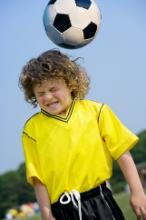
In a stunning development in the debate over soccer heading, the United States Soccer Federation ("USSF") announced on November 9, 2015 a series of steps aimed at reducing the risk of head injuries in soccer and better managing them when they occur. As part of a settlement resolving a pending class-action lawsuit filed against USSF and others in 2014, the organization will now ban players age 10 and younger from heading the ball and limit heading in practice for those from age 11 through 13 in programs it directly controls, and recommend that youth soccer organizations not under it control follow such new rules.
Specifically, U.S. Soccer has now come out against heading in practices or games at the U11 level and younger, and that heading in training at the U12 and U13 be limited to a maximum of 30 minutes per week with no more than 15-20 headers per player per week.
New rules criticized
Commenting on the new rules in an email, Dawn Comstock, the author of a 2015 study on heading in soccer[1] - which viewed a ban on heading in soccer before a certain age not only as culturally unacceptable in a sport that has been allowed to become more physical over time, but as a less effective way to prevent concussions than by reducing athlete-athlete contact across all phases of the game through better enforcement of existing rules, enhanced education of athletes on the rules of the game, and improved coaching - stated that, "As always, I support any and all efforts to keep young kids as safe as possible while playing sports, so, in general, I support the new U.S. Soccer initiative."
But Comstock expressed four concerns. First, she wondered "what effort will be made to educate all those affected by the recommendations but not actually included in the requirement?" Second, she had concerns about enforcement and feasibility: "who will enforce these new regulations and what will be the penalty for violating them, and from a feasibility [standpoint], who will be counting how many headers each athlete takes in each practice and where/how will that be recorded and referred to?
Third, Comstock questioned the rationale for limiting heading in practice for 12- and 13-year-olds but allowing heading in games. "This is completely backward from an injury prevention perspective," she said, "since concussion rates are significantly higher in competition and because we want young athletes to learn proper technique in the controlled practice environment."
Finally, fourth, Comstock reitterated her view that there was "no strong scientific evidence for these age cut points."
Likewise critical of U.S. Soccer's actions was Chris Koutures, the lead author of a 2010 clinical report by the American Academy of Pediatrics (reaffirmed in 2014).[2] "There is no evidence-based, peer-reviewed literature to support a ban on heading at age 11 versus age 14, versus any age for that matter. When the American Academy of Pediatrics Council on Sports Medicine and Fitness looked at the introduction of heading in youth soccer, we concluded that it "only be taught when the child is willing to learn proper technique and has developed coordinated use of his or her head, neck, and trunk to properly contract the neck muscles and contact the ball with the forehead." This came from consensus opinion of our members, not from any direct study interpretation.
So, "as for the ban on heading U11 and under" is concerned, Koutures was "fairly OK with that, [because] most kids [at] those ages tend to shy away from balls in the air and I can't fathom most kids U11 and under [being] able to muster the ability to protect themselves and initiate coordinated head, neck and trunk action." As a result, said Koutures, that U.S. Soccer came out against heading U11 "is fairly consistent with our AAP recommendations."
Having said, however, Koutures viewed the practice limitations in heading at U12 and U13 as "arbitrary" and without "roots in evidence-based studies." They may prove to be a "good start" or "we may learn down the road that even those restrictions may allow too much exposure." The fact is, he said, that we "just don't have that supporting knowledge at this time."
Koutures also expressed concern that people will look strictly at the numbers of headers taken in practice and not watch the kid. He cited as an example pitch counts in baseball, which, while well-intentioned, sometimes cause some parents/coaches to focus just on the number of pitches, without observing the pitcher's performance on the field. "There is no apparent concern about fatigue [as long as] the pitcher is 'under his limit', even if his pitches are way out of the strike zone, he is grimacing on every throw and shaking his arm between pitches." Koutures cautioned that, when heading is introduced, "it will be important to look not just at numbers. but on how the kid is approaching and relating to the ball. Any evidence of shying away or hesitation, forget the number, that session should be done."
That the new U.S. Soccer guidelines on heading in soccer make no mention of the importance of neck strengthening, which studies show may reduce brain trauma from heading, Koutures said was "disappointing, as again, if the goal is to protect kids, then publicizing the emerging and growing body of literature that supports neck strengthening would be quite sensible." "The realist is me grudgingly must admit that even with great data and programs (on-line, free, evidence-based) for ACL injury reduction, adoption has been quite dismal, and perhaps that's in part why neck strengthening could suffer the same fate and thus not be as attractive to promote."
Also critical of the new soccer heading rules was Michael Kaplen, an attorney who represents concussion victims and teaches brain injury law at George Washington University Law School, who told NBC News [3] that the new rules were actually a bad idea. The age limits seemed "arbitrary" and "stupid," Kaplen said. He advocates a complete ban for youth players.
And they make it seem like U.S. soccer officials found a fix, he said.
"These leagues are trying to solve a concussion problem by creating rules that give people a false sense of security," Kaplen said. "By creating rules, they imply they have addressed and solved this problem, which they have not."
Praise for soccer heading ban and practice limits
Not surprisingly, those who favor banning heading in soccer, including the Concussion (formerly Sports) Legacy Institute, which in 2014 launched a Safe Soccer Campaign calling for a ban before age 14,[3] offered qualified praise for the new rules.
Commenting on the new rules for NBC News [50], CLI's Executive Director, Chris Nowinski, said the new rules fell short because they left middle school-age players vulnerable.
"From that perspective, we still have a ways to go," Nowinski, said.
But Nowinski also told NBC News that it was a good sign that U.S. Soccer was wiling to draw a line somewhere. "For soccer to even set an age is a big step," he said.
Concussion Legacy Institute co-founder Dr. Robert Cantu predicted that the new rules would cut the number of concussions among the youngest players and shorten the time when those children are at risk for experiencing "sub-concussive hits" that can cause brain injuries later.
Children between the ages of 10 and 12 are most susceptible to concussions because their brains are underdeveloped and their necks are not strong enough, Cantu said.
By delaying the introduction of headers, Cantu asserted, U.S. Soccer "is avoiding the most injurious time period for the brain - and you're also shortening the total amount of trauma somebody takes," he said.
1. Comstock RD, Currie DW, Pierpoint LA, Grubenhoff JA, Fields SK. An Evidence-Based Discussion of Heading The Ball And Concussions in High School Soccer. JAMA Pediatrics 2015; doi:10.1001/jamapediatrics.2015.1062 (publilshed online July 13, 2015)
2. Koutures C, Gregory A, and The Council on Sports Medicine and Fitness. Clinical Report: Injuries in Youth Soccer. Pediatrics 2010;125:410-414. Reaffirmed May 2014 (http://pediatrics.aappublications.org/content/132/1/e281.full)
3. Sports Legacy Institute, "US Women's Soccer Legend Brandi Chastain, Sports Legacy Institute and Santa Clara Institute of Sports Law and Ethics Launch Educational Campaign on Concussions and the Risks of Heading In Soccer Before High School." (press release; June 25, 2014)(http://www.sportslegacy.org/wp-content/uploads/2014/06/Soccer-Heading-Pr...)(accessed August 2, 2014).
Posted November 11, 2015



